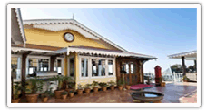|
|
|
| |
Travel destination in India, Gwalior |
| |
[ Book Hotels in Gwalior] |
[ other Travel Destinations in India ] |
| |
General Information about GWALIOR |
Gwalior :
Area : 5214 sq. km.
Altitude : 212m.
Language : Hindi, English and Gujrati.
Best Time to Visit : Winters Season - November to March.
State : Madhya Pradesh.
Location : Gir, 42-kms From Junagadh, Gujarat.
STD Code : 91751. |
About Gwalior
Gwalior is a city in Madhya Pradesh , India . It lies 76 miles (122 km) south of Agra with a population of 690,342. Gwalior occupies a strategic location in the Gird region of North India , and the city and its fortress have served as the center of several of North India's historic kingdoms.
Gwalior is the perfect entry point into Madhya Pradesh. It will instantly give you a feel of the state's history, landscape and people. The people of Gwalior are as tough and resilient as its terrain.
CLIMATE
The climate of Gwalior is extreme with hot summers and cold winters. The maximum temperature during the summer months can touch as high as 46°C, while in the winters it can go down to below 5°C. Monsoon starts from the first week of June and remains there till August/September.
HOW TO REACH THERE
By Air : Gwalior is connected by Indian Airlines to Bombay, Bhopal, Indore, and Delhi.
By Road : The most common and cheapest way of moving around the city is the six-seater auto-rickshaws. Taxis are also available so are mini buses
By Rail : Gwalior is on the main Delhi-Bombay and Delhi-Madras rail link. Among major trains, the Taj and Shatabdi Express connect Gwalior with Delhi and Agra. Gwalior is well linked with Agra (118 km), Mathura, Jaipur (350 km), Delhi (321 km), Lucknow, Bhopal (423 km), Chanderi (239 km), Indore (486 km), Jhansi (101 km), Khajuraho (275 km), Ujjain (455 km), and Shivpuri (114 km).
MAIN ATTRACTIONS IN GWALIOR
• Gwalior Fort : Built in the 15th century by Raja Mansingh Tomar on a hilltop, the mighty Gwalior Fort overlooks the city. The outer wall of the fort stands two miles in length and 35 m in height.
• Man Mandir : Man Mandir is the major attraction of the fort. The palace built by Man Singh Tomar is a delicate structure exhibiting a sense of joy and abandon through use of colour, motif, and design. There are chambers for affairs of state as well as those for relaxation, adorned appropriately and ornately with carved animals, flowers, and the human form.
• Gujari Mahal : If Man Mandir reflects Man Singh's aesthetic sensibilities, Gujari Mahal speaks of his love. The courage and beauty of Mrignayani and her love with Raja Mansingh are now a part of popular folk tradition. The palace has been now converted in a museum and houses very good collection of Jain and Hindu artifacts.
• Teli-ka-Mandir : Contrasting with the predominant north Indian style of architecture is the Teli-ka-Mandir. This temple is believed to the oldest in the Fort, built in the ninth century and Dravidian in form. The sculptures are distinctly north Indian. Some believed it was so named because it was built in the Telangana style; others say this was because it was built by telis (oil merchants). A more recent study ascribes it to Telap Raj, a prime minister of the region.
• The Sas-Bahu temples : The Sas-Bahu temples, in another part of the Fort, are not, as people believe, dedicated to a mother-in-law (Sas) and daughter-in-law (Bahu). Sas-Bahu is the name traditionally given to two adjoining temples of different sizes. The larger of the two is profusely sculpted with graceful figures and intricate patterns. This is more apparent in the interior where, above the sculpted walls and pillars, an elaborately carved lotus adorns the roof. |
|
|
|
|
|
|







